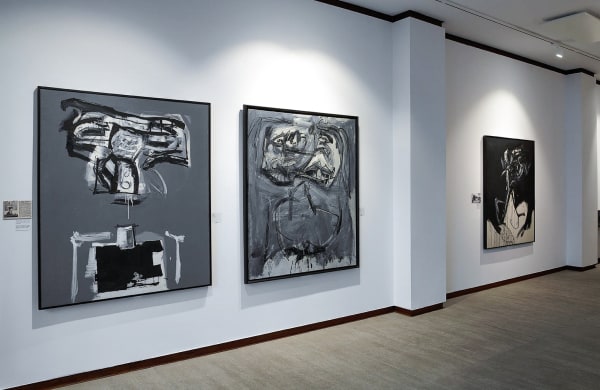Saura. Tragedy & Creation: BARCELONA
"Saura: Tragedy & Creation" includes the masterpiece Salvatierra (1957), exhibited at the 29th Venice Biennale in 1958, as well as a selection of Damas, in which the female figure is depicted in differing yet similar ways. In Saura’s words, they were born of a “compelling need to scream,” of an urge “to express oneself no matter how, by making all the energetic possibilities of the universe our own.” These works inaugurate a new phase in his imagery, with the idea of pictorial form emerging from a kind of “hand-to-hand” combat, with no concern for composition, colour or balance—Stima (1959) and Pandora (1960) are good examples.
They are paintings resulting from confrontation; from a battle that transforms inert matter into a movement originating in “figurative desire.” All the works exemplify how Saura had been searching for a new kind of representation through material that bears the stigma and the imprint of humanity. The relationships between figure and abstraction, between ground and living being, and between rising up and drowning are also evident, showing that he was fully aware of the inevitable, dramatic and joyful balance between man and his existence, as, for example in 40 superposiciones (1975).
As Barbero stresses in his text for the exhibition catalogue: “His colour choice, nearly always dominated during this period by black and white or shades of grey, is linked to that distinctive silence full of gestures and thrusts, which are characteristic of paintings by the Spanish greats. The clearest reference to the relationship with history and politics, but also to the investigation of the human and figural dimension, can only be that of Goya, just as many have pointed out before. The more drastic, radical and controversial sense of Goya’s paintings can be found in the Spanish master’s relationship with the representation of the body and, eminently, with the idea of the portrait that, beyond effigy, focuses heavily on expression. This transmigrates into an idea of dramatic and free painting that Saura was developing so that ‘it could be the expression of a total reality.’”
This exhibition asserts that Saura’s message is still relevant today by tracing a temporal arc linking his message to commonplaces such as the grief caused by human cruelty, the suffering caused by social inequality, the abuses committed by the ruling classes and the hypocrisy of politicians. All these messages prevail and are evident in the work of Goya, in 20th-century art and in today’s culture and society.
For this exhibition a catalogue has been published with texts by the specialist Luca Massimo Barbero, by Antonio Saura himself, and by other experts on the artist and his context, such as Michel Tapié, Yvon Taillandier, Julián Ríos and Dore Ashton. Likewise, a selection of photographs by Jean Marie del Moral, Leopoldo Pomés, Francesc Català-Roca, Jaume Blassi, Ramón Masats and Giacomelli documenting the artist, his creative process and the studio in Cuenca.
Essential to the realisation of this project has been the collaboration of the Fondation Archives Antonio Saura (Geneva), the Centre de Documentació i Biblioteca of the Museu d’Art Contemporani de Barcelona (MACBA) (Barcelona), the Archivio Storico delle Arti Contemporanee (ASAC) Fondazione La Biennale di Venezia (Venice) and the Pierre Matisse Gallery Archives in The Morgan Library & Museum (New York).
Curated by Luca Massimo.










